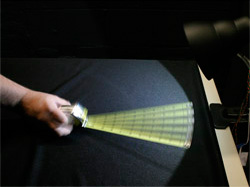The LRC has published a new ASSIST recommends publication that is designed to help LED lighting manufacturers develop systems that minimize the effects of flicker. The Alliance for Solid-State Illumination Systems and Technologies (ASSIST), which publishes formal recommendations to the LED and lighting communities regarding product reliability relative to incumbent light sources, has released a new publication that addresses the issue of flicker from LED light sources.

The publication provides calculation methods for estimating the detectability and acceptability of stroboscopic effects from flicker using the parameters of frequency and percent flicker. The calculation methods are based on work published by the Lighting Research Center (LRC) last year in Lighting Research & Technology journal.
Flicker and stroboscopic effects have long been a concern with LED lighting. In July of 2011, ASSIST funded human-factors studies of indirect flicker perception. These studies were designed to determine what light source parameters affect the detection of flicker and stroboscopic effects, and to assess subjective responses to flicker in terms of acceptance and comfort.
The results suggested that there was a tradeoff between the frequency and the modulation depth in the detection and acceptability of indirect flicker. Follow-up studies systematically evaluated this tradeoff and looked more closely at the relationship between frequency and percent flicker. The conclusions drawn from these studies led to the development of the calculation methods detailed in the ASSIST recommends publication, which provides estimations of the detection and acceptability of light source flicker for a given frequency and percent flicker.
Nadarajah Narendran, LRC director of research and organizer of the ASSIST program, notes that the methods offered can be used easily by LED lighting manufacturers to develop systems that minimize the effects of flicker. "For the past ten years, the LRC and ASSIST's industry members have investigated the technical problems impeding market acceptance of LED lighting. This is one example of the work that ASSIST is doing to provide the industry with solutions that can be implemented quickly and effectively," said Narendran.





